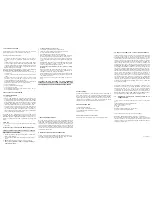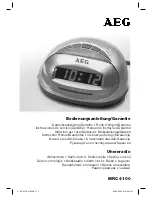
5. LOCATIONS TO AVOID
Avoid locations where smoke may not reach the alarm in time to
provide early warning, or where alarm may not be effective.
DO NOT PLACE SMOKE ALARMS:
◊
◊
◊
◊
◊
◊
◊
◊
◊
◊
◊
In turbulent air from fans, doors, windows, etc. The rapid air
movement may prevent combustion particles from entering the
alarm.
In dead air spaces such as the peak of an “A” frame ceiling. “Dead
Air” at the top may prevent smoke from reaching the alarm in time
to provide early warning. In rooms with simple sloped, peaked or
gabled ceilings, install smoke alarms on the ceiling 90 cm (3 feet)
from the highest point of the ceiling.
Note: For complex ceiling structures, consult a safety expert for
the number of alarms required and the best locations.
◊
In very hot or cold areas where the temperature exceeds 45
°
C or
falls below 5
°
C.
Less than 6 inches (15 cm) from the wall when mounted to the
ceiling.
Nuisance alarms result when smoke alarms are located where
interference may occur with the sensing chamber. To avoid
nuisance alarms, DO NOT place smoke alarms:
In high humidity areas such as bathrooms and attics. Place smoke
alarms at least 10 feet (3 metres) away from bathrooms.
In insect-infested areas.
In poorly ventilated kitchens or garages.
In very dusty or dirty areas.
Near fluorescent lights. Place smoke alarms at least 5 feet (1.5
metres) from fluorescent lights.
6. INSTALLATION AND TESTING
A. Test Before Installation
◊
Connect battery
Storage in low humidity and certain transportation conditions may
cause electrostatic charges to build up in the alarm system housing.
Although harmless, these charges may increase the length of time
during which the horn sounds upon battery insertion or test button
operation. The condition may be cleared by gently wiping the
inside and outside of the plastic cover with a clean, damp cloth.
Check the alarm by depressing the test button until the horn
sounds. Note: It may be necessary to depress the test button for a
few seconds for the alarm to sound. An alarm is indicated by a
loud continuous beep sound. Alarm may continue to sound for up
to 10 seconds after the button is released.
IF THERE IS ANY QUESTION AS TO THE CAUSE OF AN
ALARM, ALWAYS ASSUME THAT IT IS DUE TO AN ACTUAL
FIRE AND FOLLOW YOUR FIRE EMERGENCY PLANS. Do not
assume it is a nuisance or false alarm. Valuable time for escape could
be lost.
Alarm Test
.
◊
At least once a week, press the test button until the alarm sounds,
then release.
B.
INSTALLATION INSTRUCTIONS,
READ CAREFULLY.
THIS ALARM MUST BE INSTALLED BY A LICENSED
ELECTRICAL CONTRACTOR.
•
This smoke alarm will function correctly either as a stand-alone
alarm or inter-connected.
•
All interconnected alarms must be supplied from a single power
circuit.
•
Do not
connect White inter-connect wire to live or neutral.
•
Do not connect the smoke alarm to a circuit protected by a
residual current device.
•
Connect to 220-240V AC power only.
•
Live=Brown; Neutral=Blue; Inter-connect=White
•
Check connections carefully before closing the junction box.
•
Incorrect connection may damage the unit.
◊
A mounting plate is provided on the back of the alarm.
◊
◊
◊
◊
◊
◊
◊
Remove the mounting plate from the back of the alarm by holding
the mounting plate and twisting it anti-clockwise. (See Figure 4).
After selecting the proper smoke alarm location as described in
section 3 and shown in the diagram, attach the mounting plate to the
ceiling.
FOR WALL MOUNTING, after selecting the proper smoke alarm
location as described in section 3, use the screw and anchors
provided
to attach the mounting plate to the wall.
Wall mounting of this alarm may not be as effective as ceiling
mounting.
Insert battery into the battery compartment ensuring the correct
battery polarity is observed. To ensure proper installation of the
SMOKE ALARM battery, follow the instructions.
When installing the battery, align the smoke alarm terminals with
the appropriate terminals of the battery and push battery into the
compartment. (See figure 3).
During power up it is usual for this smoke alarm to emit several
beeps.
CAUTION: IF THE BATTERY IS NOT PROPERLY
INSERTED INTO THE BATTERY COMPARTMENT, THE
UNIT WILL NOT ATTACH TO THE MOUNTING PLATE
.
7. BATTERY REPLACEMENT
Model SA 800 the Eveready 216, 552, 1222, Duracel MN 1604, Gold
Peak 1604A and 1604P are the only acceptable batteries for use in this
smoke alarm. Under normal conditions it is recommended to replace the
battery once a year. When battery reaches the end of its normal life, a low
battery warning (intermittent beeping) for up to 7 days, will indicate the
need for battery replacement. When replacing batteries, ensure that
positive and negative terminals on the battery line up with the matching
terminals in the smoke alarm.
8. MAINTENANCE AND TROUBLESHOOTING
Vacuum every six months. Your Smoke Alarm should be cleaned every
six months to help keep the unit working efficiently. Keep the vacuum
nozzle from touching the unit. Do not paint the unit.
FALSE ALARMS:
Abnormal air conditions may cause the highly sensitive smoke alarm to
give a “false” alarm. If no fire is apparent, press the “hush button” briefly,
this will silence the alarm for approximately 8 minutes. During this time
ventilate the room and/or blow fresh air into the unit to clear the smoke
chamber. After approximately 8 minutes and providing the smoke
chamber is cleared, the smoke alarm will automatically reset.
TRY THE FOLLOWIMG:
◊
◊
◊
◊
Inspect for obvious damage.
Gently vacuum as recommended above.
Check that the battery is properly connected.
Replace battery.
DO NOT DISCONNECT THE BATTERY
.
Dust can lead to excess sensitivity. Vacuum as recommended above.
9. WARRANTY INFORMATION: 5 YEAR LIMITED WARRANTY
Chubb Fire Safety Limited warrants to the original consumer purchaser
each new Smoke Alarm to be free from defects in material and
workmanship under normal use and services for a period of two (2) years
from the date of purchase. Chubb Fire Safety Limited agrees to repair or
replace, at its option, any defective Smoke Alarm provided it is returned
with postage prepaid and with proof of the purchase date to Chubb Fire
Safety Limited. This warranty does not cover damage resulting from
accidents, misuse or abuse or lack of reasonable care of the product. THE
PURCHASER’S ATTENTION IS DRAWN TO RIGHTS IT MAY HAVE
UNDER THE TRADE PRACTICES ACT 1974 (CTH) and similar state
and territory legislation which cannot be excluded. Subject to those non-
excludable rights and provisions and the above warranty, Chubb Fire Safety
Limited will not be liable for any injury to persons or damage to property or
for any special direct or indirect or consequential loss or damage to
property or for any special direct or indirect or consequential loss or
damage whatsoever and whether as a result of negligence or fault on the
part of Chubb Fire Safety Limited or its servants, agents, suppliers and
contractors or otherwise arising out of or resulting from, whether directly or
indirectly, the use, installation or maintenance of the smoke alarm and any
warranties or representations are excluded unless given by Chubb Fire
Safety Limited in writing.
This Smoke Alarm’s manufacture and distribution is licensed by the
Radiation Safety Section of the Health Department of Victoria under
Statutory Rules 1984 no. 191, and by the U.S. Nuclear Regulatory
Commission. The 9-volt battery included with this Smoke Alarm is
excluded from the Chubb Fire Safety Limited 2 year Limited Warranty.
WHEN INSTALLING THIS ALARM FOR USE BY OTHERS, PLEASE
LEAVE THIS MANUAL OR A COPY WITH THE END USER.
10.
WHERE TO SEND YOUR SMOKE ALARM IF IT
NEEDS SERVICE:
If repair or service is required, return the Smoke Alarm, in a well padded
box to;
Chubb Fire Safety Limited ABN 4700 006 7541.
120 Silverwater Road, Silverwater,
NSW 2128 Australia
or call the
QUELL HELPLINE FREECALL 1800 654 435
For details of your nearest Quell branch.
Please send by courier or delivery service. DO NOT POST.
WARNING: Radioactive material Americium 241 1.0 microcuries.
Do not tamper with sealed source. When this alarm is no longer required, it
should be returned to the manufacturer at the addresses listed on this
instruction leaflet or to the Department of Health. Alternative methods of
disposal are not permitted.
.915-7218-02




















